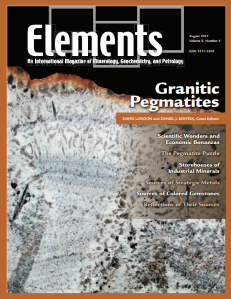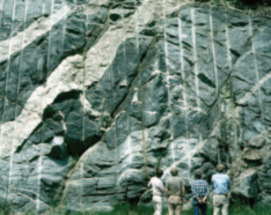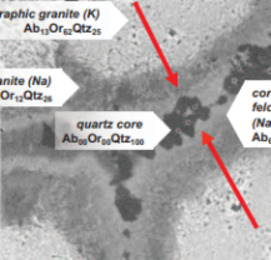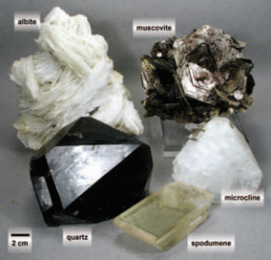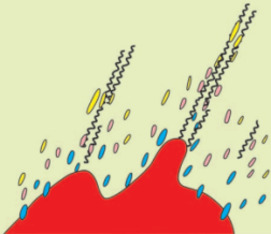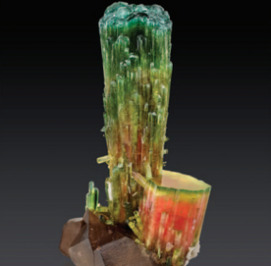
Granitic Pegmatites
David London and Daniel J. Kontak – Guest Editors
Table of Contents
Nothing that geoscientists learn as students prepares them for interpreting rock textures as complex as those found in pegmatites. Understanding the textures and mineral zonation of granitic pegmatites is tantamount to understanding the fundamental process of crystallization. It is a challenge to our ability to discern, beyond reasonable doubt, what is igneous and what is hydrothermal. this is the context that has drawn many professional geoscientists to the study of pegmatites for all or part of their careers. In addition, granitic pegmatites are important to our society as sources of raw materials for glasses and ceramics, silicon for microprocessors, and specialty metals including Li, Cs, Be, nb, ta, sn, ree, and U. a very few pegmatites provide some of the most highly prized mineral specimens and colored gems found in national museums and personal collections around the world. no other rock type presents such a diversity of economic commodities in such concentrated fashion.
- Granitic Pegmatites: Scientific Wonders and Economic Bonanzas
- The Pegmatite Puzzle
- Granitic Pegmatites: Storehouses of Industrial Minerals
- Granitic Pegmatites as Sources of Strategic Metals
- Granitic Pegmatites as Sources of Colored Gemstones
- Granitic Pegmatites as Reflections of Their Sources
Bruker
Bruker Nano
CAMECA
Excalibur Mineral Corporation
FEI
Leonard Himes Fine Minerals
McCrone Microscope and Accessories
Nikon Metrology
Pala International
Peg 2013
Geochemist’s Workbench
Rigaku
Savillex
SPECTRO
v8n5 RARE EARTH ELEMENTS: MINERALS, MINES, AND MAGNETS
Guest Editors: Anton r. Chakhmouradian (University of manitoba) and Frances Wall (University of exeter)
Rare earth–based materials have practical applications in transportation, renew able energy, medicine, household items, visual arts, forensic science, and defense, and thus are essential to the progress of humankind. the rapid development and implementation of innovative and green technologies in the past decade have resulted in greatly increased demand for rare earth elements (ree). this demand has been amplified by the current situation in the supply market and by growing public concern about unlawful or unethical extraction of certain rare metal resources. the renewed interest in rare earth resources in the explora tion and public sectors requires a much better understanding of these resources and their host rocks than currently available. this thematic issue will present a comprehensive overview of the key geological, geochemical, and mineralogical aspects of ree distribution in the crust and principal deposit types. It will also discuss economic, political, and environmental issues related to ree mining.
- Introduction to Rare Earth Elements Anton R. Chakhmouradian (University of Manitoba) and Frances Wall (University of Exeter)
- Rare Earths as a Complex Commodity: World Demand and Market Trends Jack Lifton and Gareth Hatch (Technology Metals Research, LLC)
- Rare Earth Mineralization in Igneous Rocks: Concepts and Misconceptions Anton R. Chakhmouradian (University of Manitoba) and Anatoly N. Zaitsev (St. Petersburg University)
- Hydrothermal Mobilization of Rare Earth Elements Anthony E. Williams-Jones (McGill University), Iain Samson (University of Windsor), and Artas Migdisov (McGill University)
- Diversity of Rare Earth Deposits: The Key Example of China Jindrˇich Kynický (Mendel University, Brno), Martin Smith (University of Brighton), and Cheng Xu (Peking University)
- Rare Earth Exploration and Mining in North America Anthony N. Mariano (Consultant)
- Impact! (February 2012)
- Minerals, Microbes, and Remediations (April 2012)
- Fukushima Daiichi (June 2012)
- Granitic Pegmatites (August 2012)
- Rare Earth Elements (October 2012)
- Urban Geochemistry (December 2012)
Download 2012 Thematic Preview


